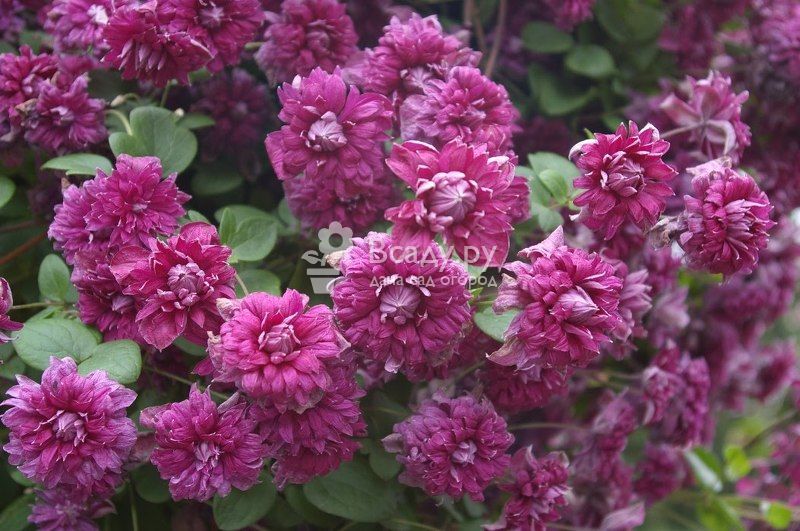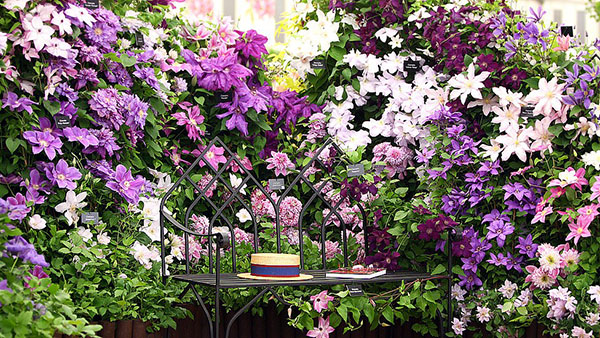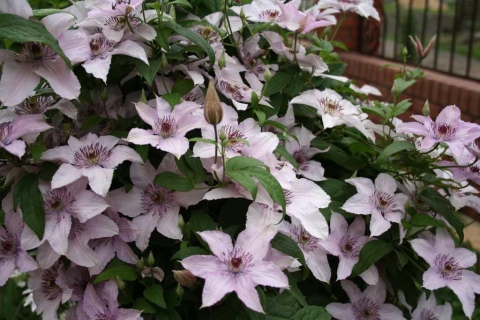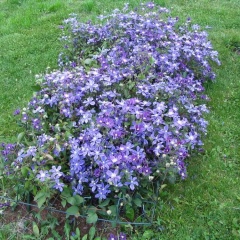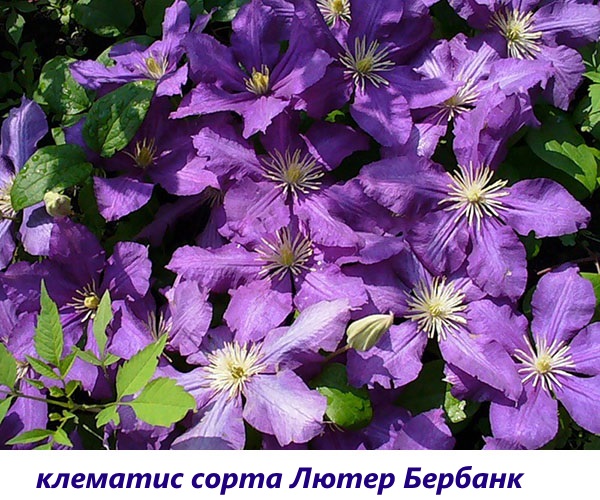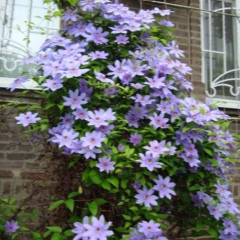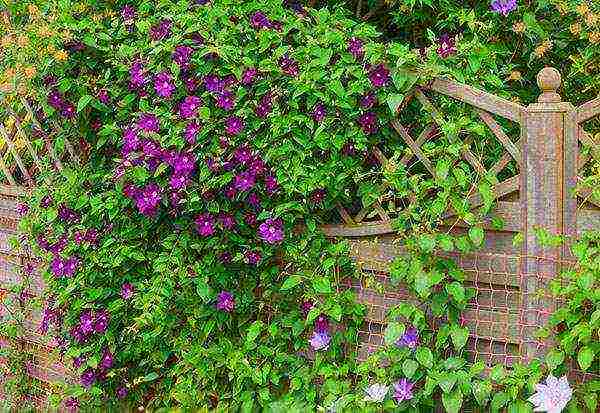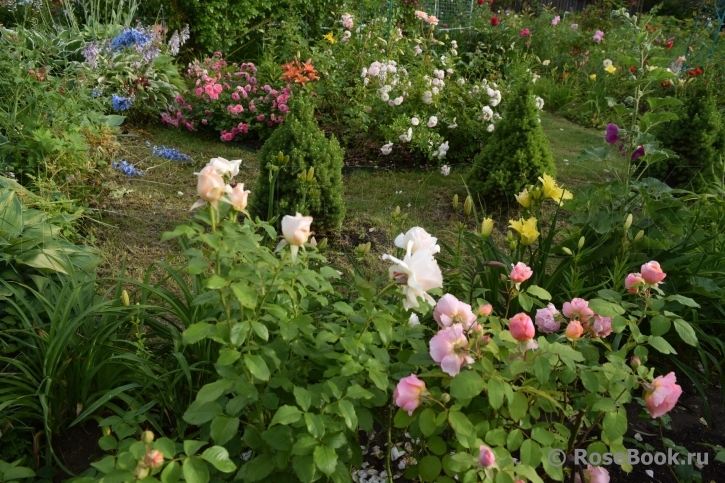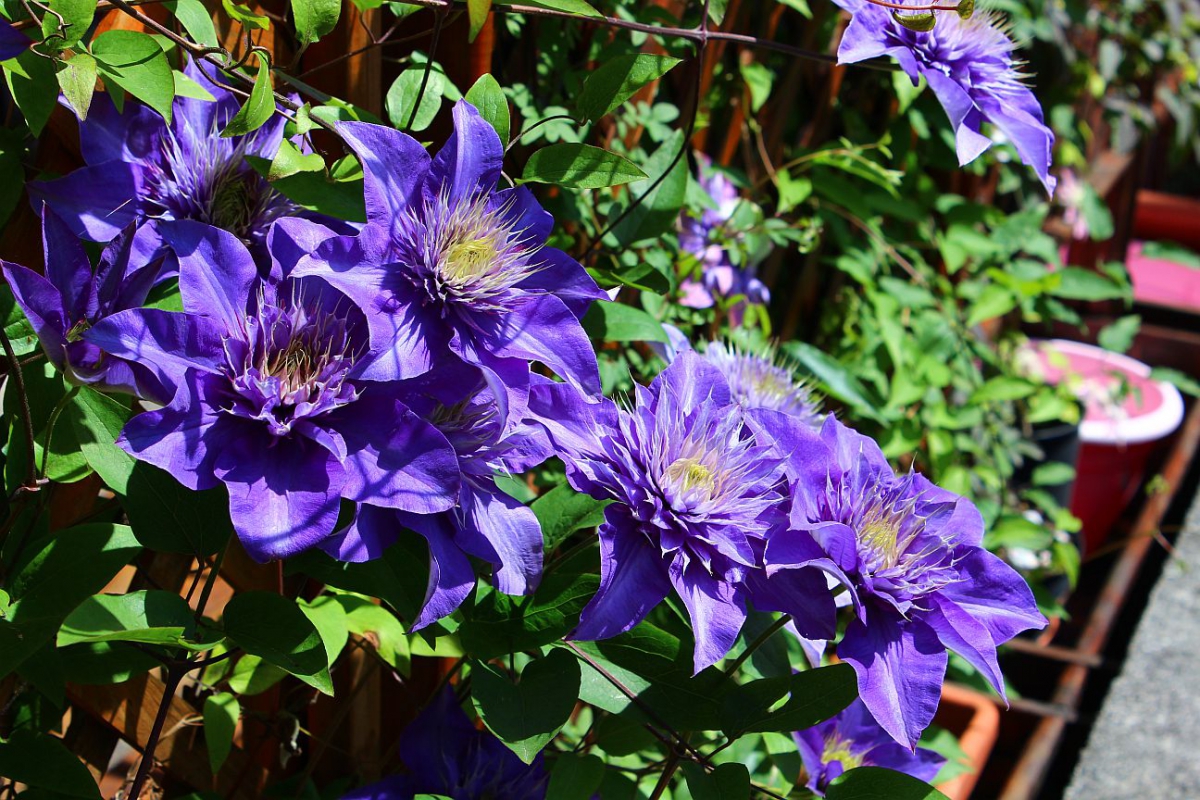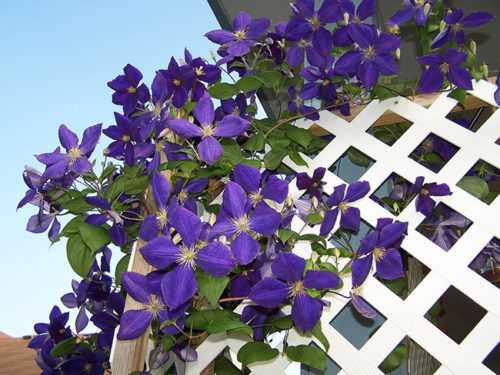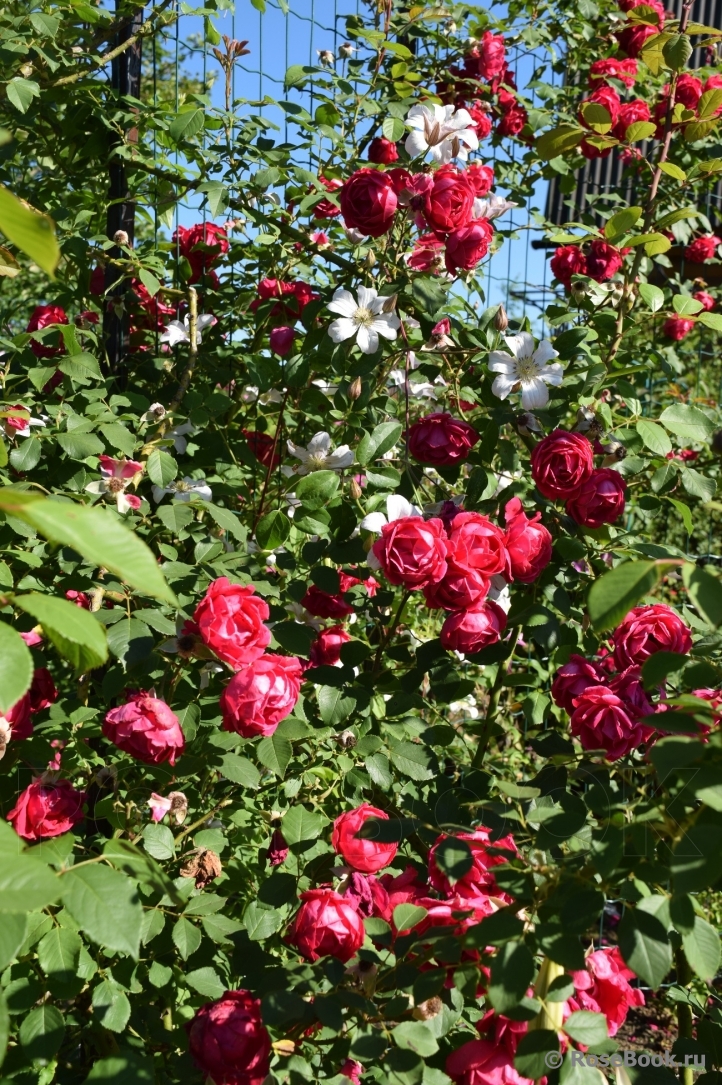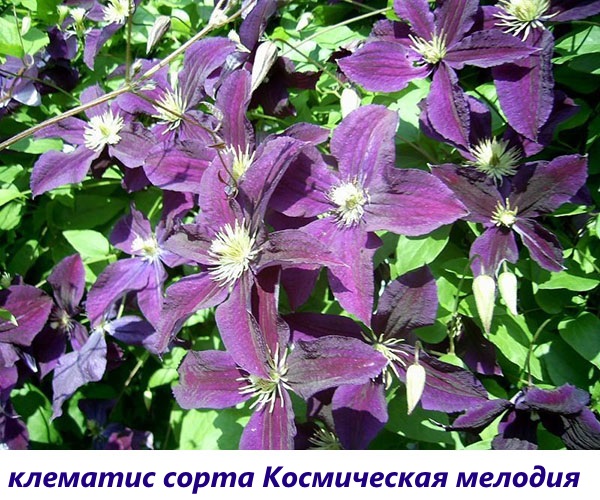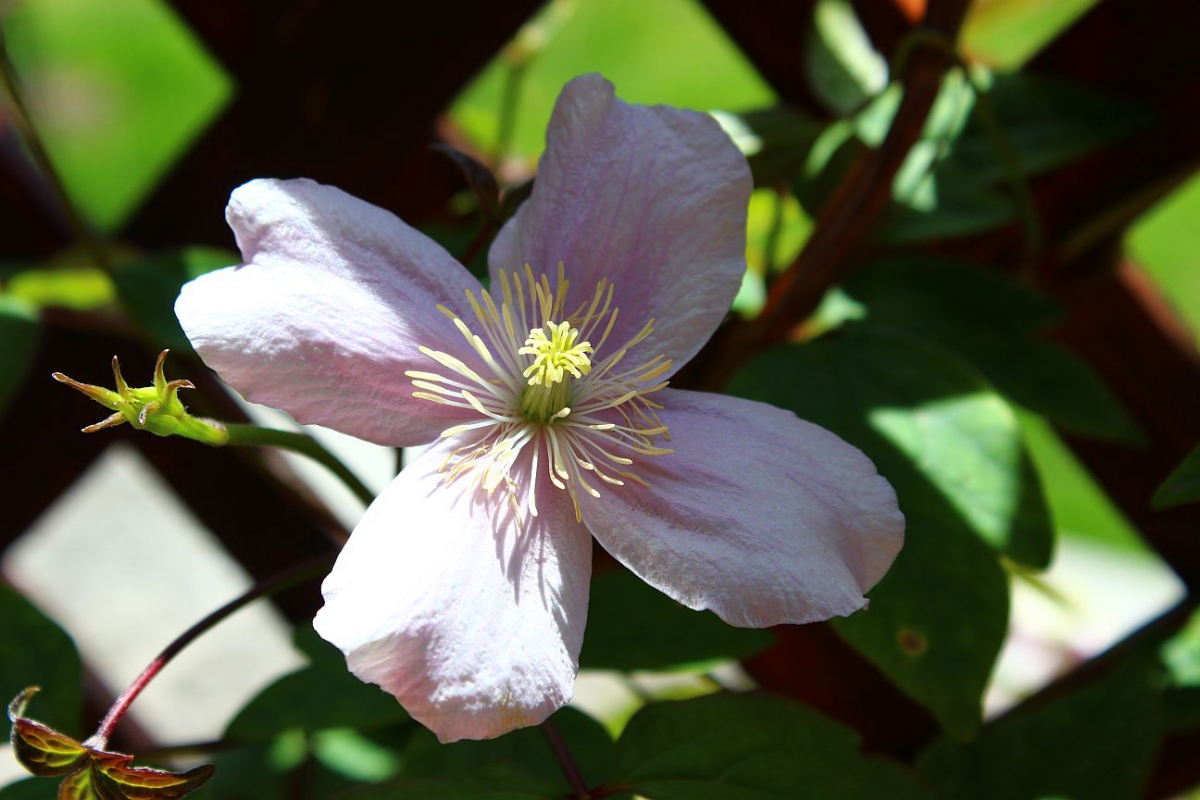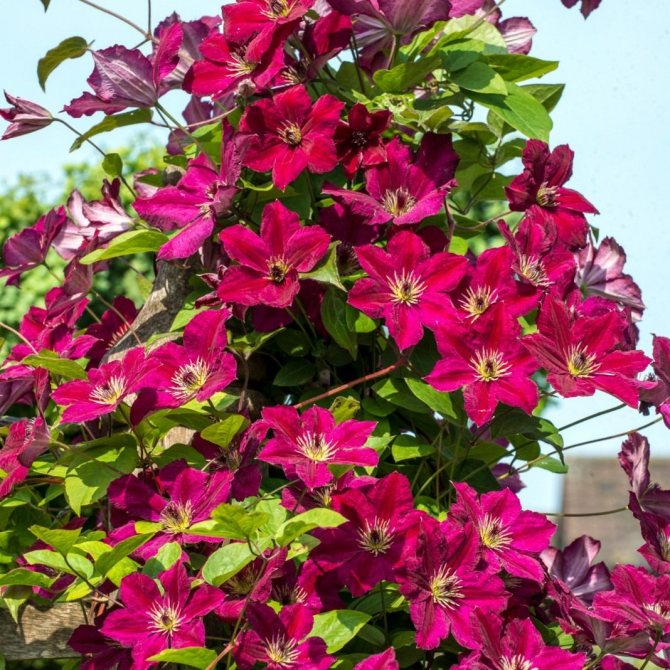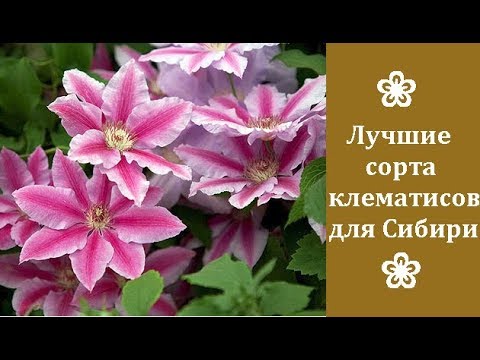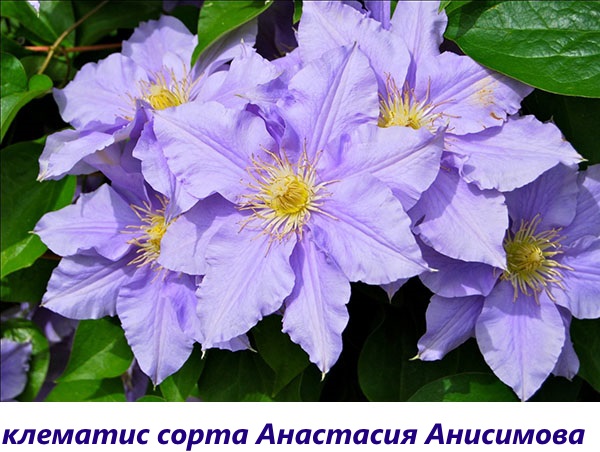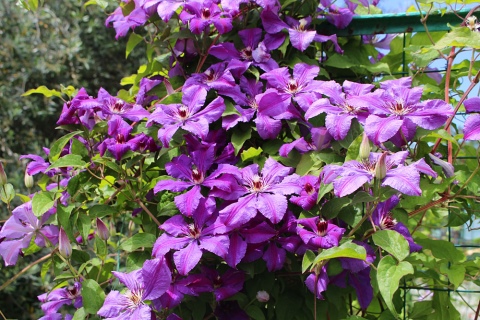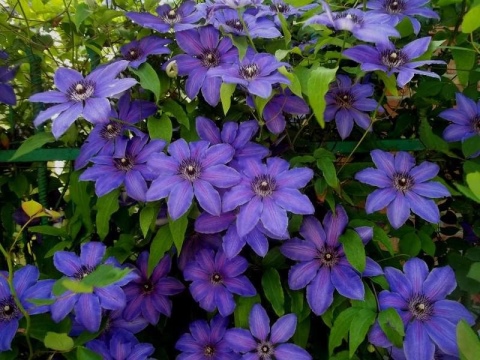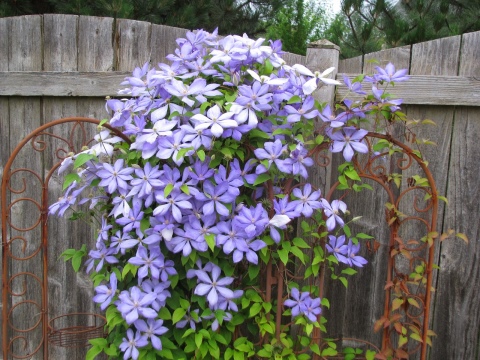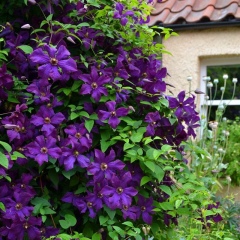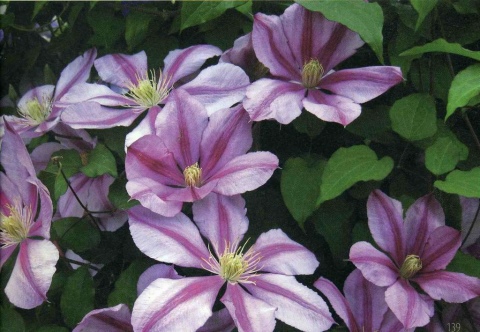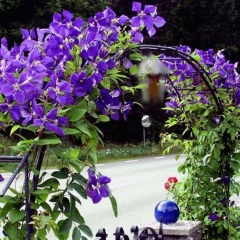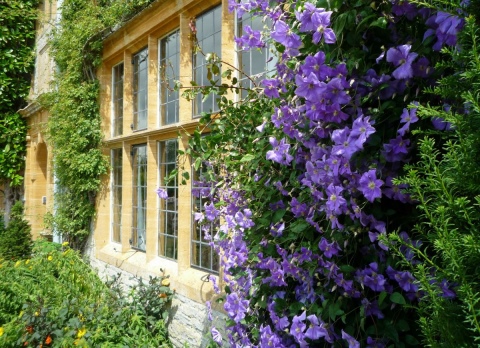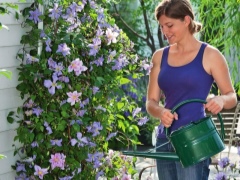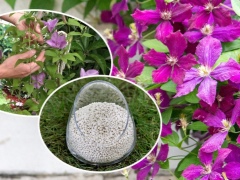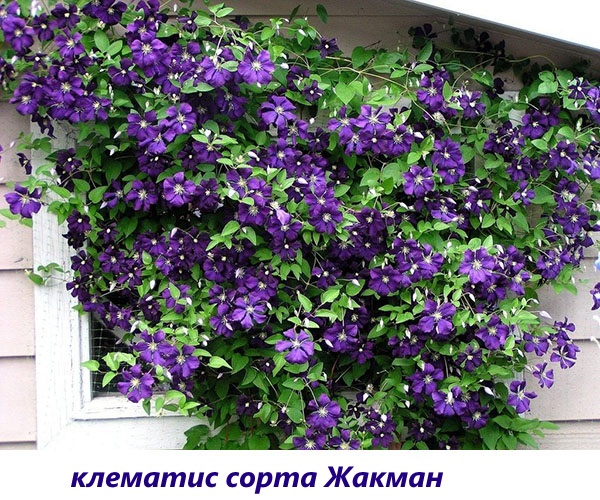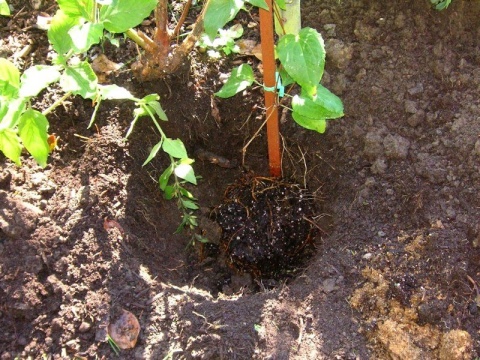Features of decorative culture
When growing any plant, you must first familiarize yourself with its characteristics and features.
The native lands of clematis are the subtropics and the temperate zone of the Northern Hemisphere. A plant of the Buttercup family can be herbaceous or woody, but most often gardeners grow vines with weaving shoots.
Leaf climbers can be characterized by a taproot or fibrous root system. Faceted shoots, distinguished by their subtlety, are formed from underground parts or above-ground points of a tree. Simple or compound leaves can be lanceolate or ovoid. Lianas are characterized by green foliage, but there are varieties that have equally attractive purple leaves.
Bisexual flowers can grow one at a time or gather in panicle, scutellum, or half-umbel-shaped inflorescences. Simple flowers have 4, 6 and 8 petals; double species may have several dozen. A large number of stamens and pistils form a furry center, similar to a spider. Clematis are characterized by a variety of shades: they are white, yellow, pink, purple, blue, etc. Fluffy fruits, collected in compound fruits, are characterized by a nut-like shape.
Vines bloom for 3-4 months. Flowering of high clematis, reaching 3-4 m in height, occurs in the upper part of the shoots. This nuance should be taken into account when choosing a place for planting and installing a support for a vine. Usually the shoots are tied up so that they tilt down. Such an organization of the plant allows you to beautifully decorate arches and fences. In low species, there is an almost complete combination of the vegetative and generative parts. During flowering, almost the entire tree is covered with beautiful flowers. But this feature prevents cuttings, since only the vegetative elements of the plant go to the cuttings.
How to transplant clematis
Considering that the movement of clematis is difficult, the choice of a place for planting should be approached carefully
There are several important factors to pay attention to:
- The soil. Clematis needs a nutritious and breathable soil. Its root system does not tolerate stagnant moisture, for this reason, places of stagnation of melt or rainwater should be avoided. It is also not recommended to place the vine in areas where groundwater is close to the surface.
- The sun. Like many flowering plants, this vine needs sunlight. It is better to place it in a well-lit area, in the shade it may not even bloom.
- Wind. For transplanting, it is better to choose an area protected from drafts and strong gusts of wind. Clematis shoots are fragile and can be damaged by severe storms.
- Support. An adult bush is quite voluminous and requires adequate support. When choosing a location, you should think about its installation in advance.
Important! Only by choosing the most favorable conditions for growth, you can count on the abundant flowering of clematis in the future.
Landing technology
Before proceeding directly to the planting process, you should prepare the necessary tools.
Instruments
Here's what you need:
- shovel;
- secateurs or sharp knife;
- container for soil preparation;
- watering can with settled water.
Important! Water for irrigation should be at room temperature and settled. It is better to fill the irrigation container in advance and leave it in the sun for a while.
Cold tap water can damage the roots.
The soil for filling the planting hole must also be prepared in advance.To do this, the garden soil is mixed with humus, sand, ash and superphosphate in the following proportions:
- 2 buckets of humus;
- a bucket of sand;
- 2 tbsp. ash spoons;
- 3 tbsp. tablespoons of superphosphate.
Important! Having prepared everything you need, you can start the transplant
You should follow the sequence of actions and perform all manipulations with clematis very carefully.
The transplant is carried out through several sequential steps.
- Pit preparation. The deepening for planting should be twice the size of the extracted earthen lump.
- Creation of a drainage layer. The bottom of the dug hole is filled with a layer of fine gravel, gravel or broken brick.
- Filling with soil. The prepared soil should cover the drainage layer by a few centimeters.
- Pruning shoots. They should be shortened so that no more than three buds remain.
- Extracting the root system. To do this, the bush is dug in a circle, some of the longest roots are cut off. The roots should be pulled out with as large a clod of soil as possible.
- Placing the plant. The root system, together with a lump of earth, is placed in a planting pit.
- Filling with soil. The empty space between the root system and the edges of the pit is filled with the rest of the soil so that the root collar is located 8-9 centimeters below ground level.
- Abundant watering. One bush will require about 10 liters of water.
- Mulching. At first, the transplanted vine requires a lot of moisture. In order to avoid drying out the soil around the planting, it must be mulched with peat or dry grass.
Care after landing
Transplanted clematis requires regular watering. It is better to carry it out in the evening with lukewarm water.
Young shoots on a support
The growing shoots must be carefully guided along the support as necessary.
Before the onset of cold weather, the shoots are removed from the support and laid on the ground in a circle, having previously spread a layer of dry leaves or grass under them. For shelter, you can use a white non-woven fabric.
Important! In the first year of growth, the vine can not be fertilized. The fertilizer rate applied during planting will provide it with nutrients for the first time
If necessary, clematis can be transplanted to a new location. Before carrying out this procedure, you should decide on the place of the new planting, taking into account the preferences of this vine. To carry out these manipulations, you can choose both autumn and spring periods. When choosing, one must be guided by the peculiarities of the climate of the region where the transplant is made.
Only by following all the recommendations and planting rules can the death or disease of the plant be avoided. Also, a newly planted clematis needs regular care and shelter for the winter in the year of transplantation. If everything was done correctly, the next year clematis will delight you not only with the growth of new shoots, but also with lush flowering.
Types of clematis
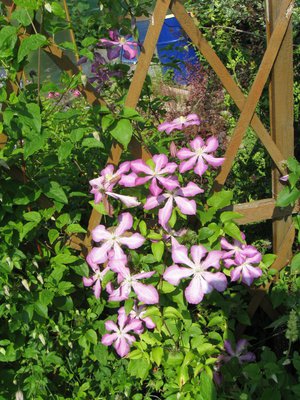 Attractive vines have been cultivated as garden flowers 500 years ago. To date, more than 300 species of plant culture are known, which are distinguished by the shape, size and color of flowers. Breeders of Western Europe have developed varieties that are more suitable for growing in regions with warm climates.
Attractive vines have been cultivated as garden flowers 500 years ago. To date, more than 300 species of plant culture are known, which are distinguished by the shape, size and color of flowers. Breeders of Western Europe have developed varieties that are more suitable for growing in regions with warm climates.
The northwestern regions of Russia are characterized by cold winters, early autumn and late spring frosts. In such latitudes, not all types of thermophilic clematis will be able to take root, which will not be able to endure wintering and bloom profusely next spring. Therefore, varieties that bloom in late winter or late autumn are not suitable for regions with harsh climates.
In the north-west of the country, low and medium-sized flower species should be planted, which grow no more than 2 m. Their flowering begins in July and ends by the beginning of autumn. Such lianas are highly winter-hardy and have small flowers.
Popular types of clematis for the northwest:
- Viorna. Creeping vines have wide, glossy, dissected leaves.The frost-resistant variety has flowers with arched petals.
- Gypsy Queen. A profusely flowering variety well resists not only frost, but also fungal diseases. Shoots are characterized by rapid growth and up to 2.5-3 m in length. Flowers that appear in August are purple on the outside and dark purple on the inside of the petal.
- "Jacqueman". On powerful and fast-growing vines during the flowering period, large flowers of purple, burgundy or pink appear. Early flowering varieties are pruned to 3-4 buds for wintering.
- "Itegrifolia". Half-open bell-shaped flowers appear on the shoots of the current year. Branches can be cut completely before winter. But such clematis will have to be tied to the supports manually.
- "Prince". The tree can grow up to 3.5 m in height. The woody stem tightly wraps around the frame. Large glossy leaves have a rich green hue and are divided into two or three segments.
- "Lasianta". A group of amazing plants is distinguished by drooping bell-shaped flowers that gather in inflorescences. The leaves are wide, glossy, dissected.
- Luther Burbank. Shoots grow up to 2-2.3 m. Large flowers are disc-shaped, 15-20 cm in diameter. The petals have wavy edges and a violet-blue color; curl outward during flowering.
- "Mephistopheles". The flowers are characterized by a cruciform shape with a diameter of 13-18 cm and dark purple sepals. Bloom lasts from July to October. The length of the branches reaches 3.5-4 m. Mephistopheles are highly resistant to fungal diseases.
- "Melody". A shrub-type liana grows no more than 1.6-1.9 m. The diameter of the flowers is within 10-15 cm. The fine-toothed sepals are characterized by a pearl-pink color. The winter-hardy species is distinguished by abundant flowering, which begins in July and lasts until the onset of frost.
- Piilu. Shrub vines grow up to 1.8-2.1 m. Flowers are characterized by a light purple or pink tint. A crimson stripe runs along the center of the petals. Flowers 12-14 cm in diameter are characterized by bright yellow flowers. The plant blooms profusely on young shoots; double forms appear on old branches.
- Rouge Cardinal. Shoots reach 2.2-2.6 m in length. Sepals have a velvety and reddish-purple hue with a lightened central stripe along the petals. Abundant flowering begins in July and ends in September.
- "Florida". Large flowers of light shades appear on last year's shoots. The tree can be heavily pruned, leaving at least a meter in length, but next summer it will bloom late.
- Ernest Markham. Shoots grow up to 2.5-3 m. Disc-shaped flowers reach 13-16 cm in diameter. The species is characterized by sepals, which have a red-purple hue on the inside and a smoky-purple hue on the outside. Liana blooms profusely from August.
Clematis trimming groups
Depending on how and at what time clematis blooms, its pruning group is determined. At the moment, when we are trying to figure out which clematis are best suited for Siberia, we are interested in those varieties in which flowers appear most intensively on the shoots of the current year. This means that shoots appear immediately after winter and they need some time to develop and only after that flowers will appear on them. Most often, flowering begins in June-July, and even in September. This type of flowering gives the variety a third pruning group, because such shoots are completely removed before winter. Yes, such clematis will bloom, perhaps not so long, but this is much better than their complete absence in your garden.
Since most shoots are almost completely cut off before winter, the plant is much easier to cover: only the root zone of the plant is subject to this, which, with good protection, can withstand even in frost up to 40 degrees below zero.
It is the varieties characterized by the third pruning group that interest us most, and they are the ones you should pay attention to when choosing the best winter-hardy variety for your garden.
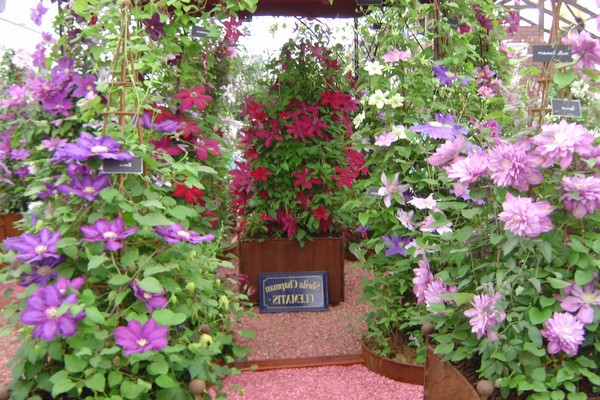
The second pruning group is characterized by fairly early flowering. The first flowers begin to appear in June or even May. Most often, they grow on last year's shoots, but this does not mean that young shoots do not give flowers at all. They do it, but, unfortunately, a little later (approximately two to three weeks). Therefore, as you might guess, trimming these clematis, like the previous group, is not the best idea. The maximum you can count on is shortening the shoot by a full third, but even that is quite a lot. As a result, it will not be possible to cover only the root zone, and you will have to resort to covering methods for the winter, which turn out to be far from so effective, especially in the conditions of harsh Siberian winters.
Nevertheless, many gardeners decided to make a rather obvious compromise: since the shoots of the current year still give flowers, a path and a little later, why not cut the clematis of the second pruning group in the same way as the clematis of the third group. Yes, it is possible that the flowering will not be so lush and there will be not so many flowers, but often the flowers of the varieties of the second pruning group have exceptional external qualities that the third group simply cannot boast of. So, if you decide on this risky move, you will not regret it. Below in this article we will offer you the most popular varieties belonging to this group.
The first group includes clematis, which do not bloom at all on the shoots of the current year. Flowers appear exclusively on those that are more than one year old. This group is the worst suited for cultivation in Siberia, since the clematis varieties belonging to it are most often not cut off at all for the deputy, and, therefore, it will be extremely difficult to cover them. Naturally, most varieties, especially without shelter, will not withstand the Siberian cold.
However, most are not all, which means there are several varieties that can cope with blizzards and frost without even having protection. However, they have a significant disadvantage: almost all of them grow wild, and therefore their flowers are far from being as beautiful as those of the third and, especially, the second group.
However, in addition to the timing of flowering and pruning, the gardener may also be interested in another factor in the classification of clematis, and this is the length of his shoots. According to this characteristic, all varieties of clematis are divided into two groups:
Shrub clematis, the length of the shoots of which does not exceed two meters.
Curly clematis, which can stretch their shoots up to four meters and even more (in exceptional cases)
If you still want to grow varieties of the first group, you will have to choose the most suitable planting site for them. The fact is that by planting them on the street, you are most likely to find them for death. Instead, it would be much more expedient to plant such varieties on the balcony or, in extreme cases, on the terrace, where they will be warmed to some extent by the warmth of your home. If your choice fell on clematis of the second or third pruning group, they can even decorate a gazebo or an empty wall of a house if their height does not exceed three meters.
Now that you know everything about which varieties are best suited for growing in Siberia, and how to figure out which one to choose, you can go directly to the description of the varieties. Many gardeners want their garden to be decorated with the most diverse and colorful plants, and therefore all characteristics, from growth to the shade of flowers, will be indicated in the description of the varieties.
Landing
In order for the culture to have the opportunity to bloom beautifully and for a long time, as well as to develop in the proper volume, a gardener or designer will need to thoroughly approach the choice of a place for planting clematis.Ernest Markham is a light-loving crop, so it is best to grow this crop on the south side. Windy places should be avoided. You can choose areas where diffuse lighting will be present most of the day. For proper growth and development, the liana will need a day of light with a duration of at least 5 hours.
The choice of soil deserves special attention. Liana will not be able to grow in soil with high acidity, and problems with growing clematis can also arise in heavy soil.


Planting can be carried out with the arrival of spring or at the very beginning of autumn. Simultaneously with the rooting of the culture, the support is immediately installed for a climbing plant... Its optimal height will be 2 meters, which will allow the plant to develop correctly.
Before planting clematis, you need to prepare a flower hole. Its depth should be at least 60 centimeters. The same dimensions should be the width and depth of the clematis hole. Regardless of the soil in which the flower will be grown, drainage should be laid at the bottom of the hole before rooting. After that, the culture is placed in the center of the pit, the root system is straightened and the plant is sprinkled with earth, forming a small mound on the surface.
Among the proposed options for clematis seedlings "Ernest Markham" should be given preference to plants, which will be at least one year old. Since it is in such crops that the survival rate will be highest after transplanting a flower into open ground.
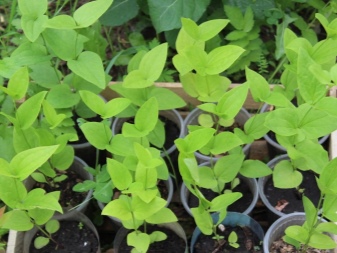
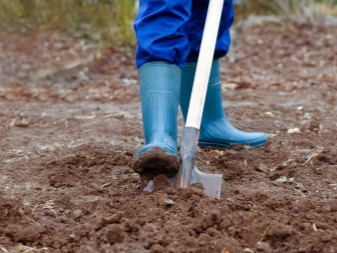
You can purchase planting material with an open or closed root system. In the first case, after removing the culture from the temporary container in which it was sold, it is worth immersing the clematis in warm water for a while.
For early adaptation and better development, you can root the vine in a specially prepared soil mixture. Humus, peat and sand will become its components. You can also additionally include lime, superphosphate and wood ash in its composition. It is recommended to take broken brick as a material for drainage. After planting, the soil around the flower must be watered abundantly, and a layer of mulch must be laid out.
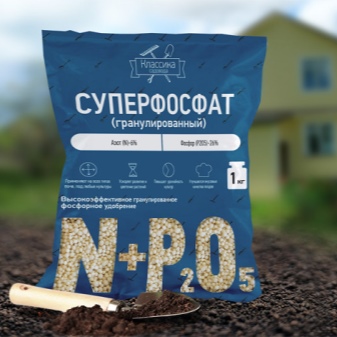
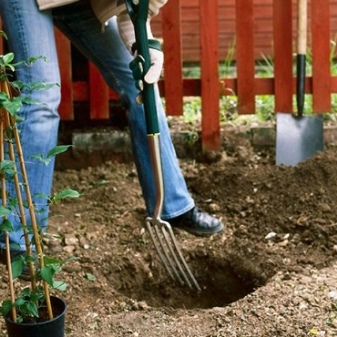
Features of clematis care
Careful care of clematis will ensure vigorous growth, rich flowering, and disease resistance.
Standard care:
- top dressing, loosening;
- watering, mulching;
- pruning clematis, preparing for winter - nothing out of the ordinary.
How to water
Watering is essential, especially in the early days after planting.
- In the initial 2-3 years, watered at least 2 times in 7 days. Pour 30 liters of water (3 buckets) under each bush.
- Starting from the age of three, a one-time watering per week is enough.
- In too hot weather, flowers are watered more often.
Than to mulch
In order to retain moisture under the bush, mulch the soil around the plant. Use rotten sawdust, peat, humus or grass. If the mulch is grass, then under its layer they are sprayed with the "Shine" agent so that mold does not form
To make clematis bloom magnificently
During the first two years, shoots hardly grow, roots develop. If 2-3 flowers appear on overgrown young stems, it is advisable to cut them off. Then more than one hundred flowers will bloom on five-year-old shoots.
Top dressing
It is advisable to feed clematis once a week.
- The first feeding is nitrogen, it contributes to the growth of green mass.
- Then 2 times a season they are fed with minerals: phosphorus, potassium.
Between mineral fertilizers, you can feed clematis with mullein or herbal infusion.
- For this purpose, 1/3 of the bucket is filled with herbs (weeded or cut grass), preferably nettles.
- Insist for at least 10 days, stirring every day.
- 1 liter of the resulting working solution is diluted in 10 liters of water and spilled under the bushes. Mullein is cooked 1:10.
Preparing for winter, pruning
Clematis are thermophilic flowers, so they are sheltered for the winter.First, the plants are pruned, but in different ways (depending on which the trimming group includes culture). This is done at the end of autumn.
Description of the trimming procedure:
- Plants in which flowers bloom on the shoots of the previous year are cut off by only a third. The remaining stems are placed on the ground in rings and covered.
- Almost to the stumps, leaving no more than three nodes, clematis is cut off with flowering only on annual shoots. Sprinkle with soil on top, lay out spruce branches. Cover with boxes, boards so that the covering material does not ram. Boards and boxes are wrapped with roofing material. In winter they fall asleep with snow.
- Plants are pruned twice, which bloom on the shoots of the last year and new ones. For the first time, they are pruned when the plants have faded, for the second time - in late autumn. The plant is removed from the supports, placed on peat, humus, spruce branches, dry leaves. Then they also cover with all available means. Non-woven fabric is excellent for this purpose.
Spring care
With the onset of warm days, there is no need to rush to open clematis in early spring. Since the spring sun is active, the night frosts have not stopped - sudden changes can destroy the buds of the plant. Only after the frost is over, you can open it.
After opening, it is advisable to feed the flowers with nitrogen (ammonium nitrate, urea).
Breeders have developed many new varieties that bloom on last year's shoots:
alpine clematis;
mountain;
Siberian and others.
These flowers are not cut off, do not cover, they winter well in the harsh winter of central Russia, not freezing in thirty-degree frosts.
Recessed planting of clematis
Clematis, like many lianas, needs a deep planting, which is caused by its biological characteristics - a tillering center is formed in the soil, in which new shoots and roots are formed. In addition, with this method of planting, the plant hibernates better, tolerates the summer heat more easily and gives more abundant flowering.
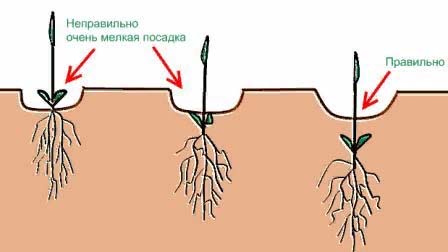 Planting scheme for clematis
Planting scheme for clematis
Planting technology for clematis. Basic steps:
Like other vines, clematis need to prepare support for the shoots. Due to the plasticity of the plant, creating a support of an interesting shape, you can get a bright decorative effect in the garden.
What clematis love for lush flowering: the tricks of experienced florists.
To grow a beautiful clematis, one must be aware that they are real gluttons, they must not be fed, but fed regularly and abundantly!
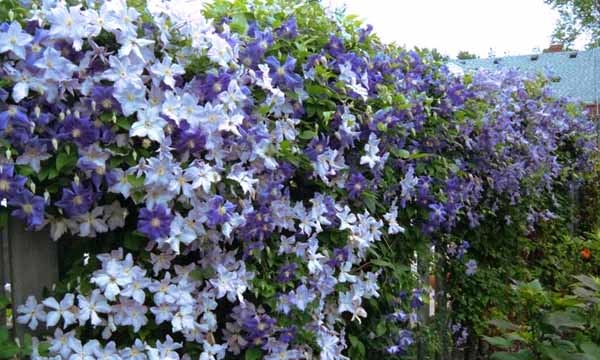
When to feed clematis. Fertilize the vine every 10 days in small portions of fertilizer, always in liquid form. We start feeding in May, when the shoots begin to grow.
How to feed:
- 1 tbsp. a spoonful of ammonium nitrate in 10 liters of water or
- cow dung in a ratio of 1:10, or
- bird droppings in a ratio of 1:15 or
- 2 tablespoons of vermicompost per 10 liters of water.
We use one bucket of mortar per bush.
How to fertilize. Alternate mineral fertilizers with organic ones. When buds appear, give both organic and mineral fertilizers.
We protect against pests. If the soil is acidic, in order to prevent the wilt disease of clematis (wilt), you need to deacidify it with milk of lime 200 g of lime per 10 liters of water. Ash is also suitable for this purpose.
We strengthen clematis. These garden vines love growth stimulants - so spray them with Epin extra every 10 days. This protects the clematis from stress, helps them survive the spring frosts successfully and makes the shoots more active.
Reproduction of clematis by cuttings and seeds (with photo and video)
The fastest way to reproduce is by cuttings. It is necessary to start cutting clematis before flowering. Cuttings from flowering shoots take root worse, they are harvested from a 3-4-year-old bush from the middle part of the shoot, at a height of 25-30 cm from the soil, with one node 4-5 cm long.To accelerate root formation, cuttings are treated with growth stimulants, for example , "Heteroauxin" (50 g / l of water for at least one day).When planting, the cuttings are buried to the nodes in a mixture of coarse sand with peat, spilled with a solution of "Heteroauxin". Cuttings are often sprayed with water. Rooting takes place after about 30 days. For the winter, they are covered with a low box, and covered with foliage on top. The next year, or in spring or August, they are planted in a permanent place.
Watch a video of clematis propagation by cuttings in the garden:
Small-flowered (species) clematis give a lot of seeds, and large-flowered (varietal) ones - very few. Seeds are small nuts-seeds, to which a fluffy "tail" is attached on a thin stem. In autumn, in place of the flower, a fluffy silvery-white head is formed from such tailed nuts. Inside each nut is the seed of clematis itself.
The ripening time of seeds in clematis is different, you need to collect brown seeds when the darkened fluffy head with ripe seeds crumbles when touched.
Traditionally, it is better to take fresh seeds for sowing.
Therefore, when buying them in stores, pay attention to the expiration date. But if the seeds are stored correctly - in paper bags at a temperature of 19-22 degrees, then they can be usable for 4 years.
Clematis seeds, according to their size, are conventionally divided into three groups
This is important, since the timing of their germination depends on the size of the seed.
Large seeds (6 to 12 mm) have a very long germination period, which can last more than a year.
Medium seeds (3 to 6 mm) germinate in a period of one and a half months to a year.
Small seeds (1.5 to 3 mm) germinate from 1-2 weeks to 3-4 months.
When clematis breeds, seeds should be laid directly in open ground at the end of April. For better germination, it is advisable to sow seeds that have already passed stratification.
As you can see in the photo, when clematis breeds, the seeds are spread over wet loosened soil and sprinkled on top with coarse sand 1-1.5 cm:
Then it is well watered by spraying. For protection from birds and direct sunlight, the sowing can be sprinkled on top with wood chips or shavings. The first shoots should appear in 20-40 days.
Freshly harvested seeds can be immediately sown in open ground in the fall, where they will naturally stratify over the winter. But in this case, germination is not always good enough. Therefore, it is better to work hard and grow seedlings.
Clematis care
In the fall, we cut off a young seedling (no matter how much has grown there, and when it was planted) and sprinkle what remains with humus. If it is possible to leave whips 50 cm long, then we lay them on the ground along the place allocated for the bush, and all this, together with the landing site, fall asleep with humus
There is no need to dig out in the spring. Shoots will crawl out of the surviving buds, and over the summer it will take root, and you will immediately get a large bush, well, and it will winter all the better.
Clematis categorically cannot stand NEIGHBORHOOD WITH WEEDS. You also need to deacidify the earth during planting, add humus, sand and add ash in half with sand every year, at least 1 bucket per bush. Clematis grow a huge green mass over the summer, they also bloom, they need a lot of food and WATER (be sure to water all summer).
Milk of lime can be shed at the base of the bushes in the spring: extinguish 1 part of quicklime with 1 part of water, then add another 9 parts of water. Before watering with milk of lime, you need to spill the ground well with water.
Ashes for digging add 1 glass per 1 square meter. Ashes in half with sand, a slide, are poured onto clematis trunks to prevent wilt diseases of clematis, wilt.
Since cracks form at the base of the stems when the lashes are rocked, infection penetrates into them. Therefore, it is important that clematis have solid, non-swinging support. And the bases of the stems are sprinkled with ash and sand.
It is better to mulch the soil. You need to fertilize clematis all season.
Clematis feel good if plants grow near their roots (but not closer than a meter) that would shade their roots (I have peonies).
Fertilization of clematis with dolomite flour is used to deoxidize the soil, it is completely replaced by chalk or ash.
You can also use sustained release fertilizers such as Pocon. Clematis very much respect nettle infusion, well, and liquid Kemira. They are generally very gluttonous.
Liquid fertilizers based on ammonia are good for clematis (they are unmistakably recognizable by smell and black color). It is necessary to buy those of them that contain, in addition to other trace elements, cobalt, boron, molybdenum.
For clematis, spring feeding with garden lime is needed, 200-300 g per 10 liters of water or 100-150 g of dolomite flour or chalk per bucket of water.
Step-by-step instructions for planting clematis in spring
Knowing the sequence of how to plant clematis correctly will help you grow a gorgeous plant in your country house.
Soil and planting rules
Soil preparation should be done in advance. This is necessary for the earth to settle. It is best to hold the event 1.5 months in advance.
What kind of soil does clematis like?
The plant prefers a nutritious and loose soil that quickly absorbs excess moisture. You can not plant a flower in the ground with high acidity. This will lead to his death.
It is important to check the moisture level when choosing a planting site. The plant does not tolerate abundant groundwater
Experienced gardeners recommend preparing artificial mounds for the comfortable growth of clematis. To remove moisture, grooves are made and covered with sand.
Planting pit preparation
Before planting the plant, the site is cleared, garbage, stones, weeds are removed. If the soil is acidic, it must be neutralized. To do this, the site is dug up, wood ash is added to the ground at the rate of 200 g per square meter.
Pit preparation
Stages of preparing the landing pit:
- You need to dig a hole 60 centimeters deep.
- Lay a drainage layer of 15 cm at the bottom. It can be expanded clay, gravel, pebbles.
- Fill the hole two-thirds with a mixture of river sand, peat, humus and sod land. You can add 150 g of mineral fertilizer.
- Then water the soil abundantly so that the soil and fertilizers can settle.
Important! It is best to leave a distance of one meter between the bushes. If the gardener wants to organize a dense flower bed, you can plant clematis at a distance of 30 cm from each other.
Choosing a place and preparing for planting clematis in open ground
When choosing a place, it must be borne in mind that the plant does not tolerate high humidity. It is necessary to avoid wetlands, stagnant water, runoff from roofs. This leads to the development of fungal diseases in the plant.
The area under the tree is not suitable for clematis. Both the bush and the tree have large roots, they will begin to pull nutrients from the soil from each other.
Clematis flowers grow well in sunlight, but the roots prefer shade. In this regard, it is best to plant ornamental grass next to it.
Planting technology for clematis
The breeding process, the timing of when to plant clematis, can be traced according to the diagram:
- The fertilizer pit is compacted.
- If a seedling with an open root system is used, then a mound is made in the center. The plant is placed on it, the roots are straightened in a circle.
- Seedlings with a closed root system are placed in the center of the pit.
- The root collar is covered with earth by 10-15 centimeters. Several buds should be hidden by the soil.
- A small groove is made around the trunk for easy watering.
- After planting, the bush is well watered, a peg is placed next to the hole, to which the seedling is tied.
- Mulching is carried out with peat or sawdust.
After planting, arcs are established around the plant, then you need to cover the plant for several weeks with agrofibre.
Clematis planting technology


